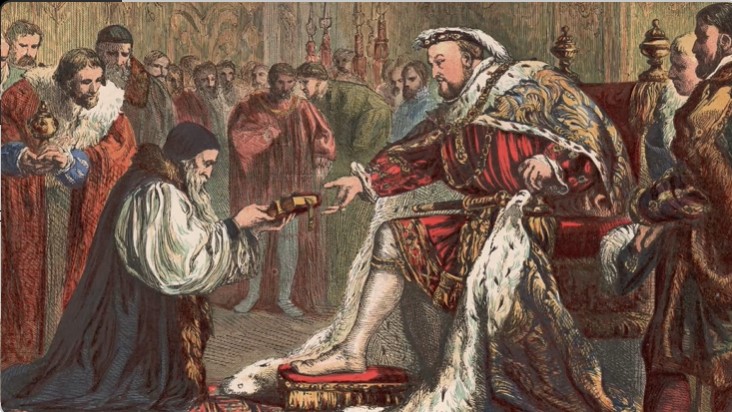
Founding of the Church of England
Political Motives
The triggering incident for the break with Rome was Henry’s desire to annul his marriage to Catherine of Aragon and marry Anne Boleyn. Securing a male heir to ensure the Tudor dynasty’s survival was a driving force for Henry. He blamed his lack of sons on Catherine’s age and wanted to remarry with the hope of producing a male heir. In addition to his personal intent to protect the Tudor dynasty, Henry saw an opportunity to increase royal power by taking control of religious matters and finances, previously held by the Pope. The break also reinforced a sense of English national identity, distinct from continental Europe.
Economic Benefits
The property of the Catholic church, especially the monasteries, was irresistible to a king with an extravagant lifestyle and a propensity to engage in foreign wars. At the time, monasteries had an estimated 25% of all cultivated land in England. Wolsey and Cromwell had previously closed small monasteries and their successors completed the takeover by 1539.
Vast amounts of monastic land, gold and silver plate were transferred to the Crown, estimated at about one and a half million pounds. The buyers – gentry and rich merchants – reaped a windfall, supporting descendants up to the present time.
Theological Change
While Henry was a devout Catholic who initially opposed the new protestant ideas, he adopted some Protestant principle that emphasized scripture over papal authority. His assumption of power was not a theological revolution, but rather a strategic maneuver to achieve his personal and political goals while maintaining certain traditional beliefs. It laid the groundwork for the later Reformation movements in England, but its origins were firmly rooted in Henry’s own ambitions. Even so, theological change was muted until after his death and the ascension of Edward VI to the throne.
The Case for Assuming the Role as head of the Church in England
Reconciling Henry taking over the Pope’s role in the Church of England required certain justifications to convince the faithful. His arguments included:
- Appealing to Scripture: Henry claimed papal authority wasn’t divinely ordained, citing biblical passages suggesting only Christ as head of the church.
- Historical Precedent: He argued English kings historically held certain religious powers (appointing bishops, overseeing Church finances), drawing on examples like King Henry II’s dispute with Thomas Becket.
- Papal Abuse: He accused the Pope of corruption, abusing indulgences, and interfering in English affairs. This resonated with anti-papal sentiment already present in England.
- Royal Supremacy: He emphasized the king’s role as God’s earthly representative, divinely appointed to rule over both temporal and spiritual matters within his realm. His supporters cited Romans 12:1-2: “All of you must yield to the government rulers. No one rules unless God has given him the power to rule, and no one rules now without that power from God. So those who are against the government are really against what God has commanded.“
- Continuity with Catholicism: While Henry claimed papal supremacy as invalid, he maintained most Catholic doctrines and practices to reassure conservative clergy and the broader population who would not support radical theological changes.
Henry’s reconciliation was more pragmatic than theological. He achieved his personal and political goals by seizing papal authority but maintained enough continuity to avoid widespread revolt.
Consequences of Henry's Actions
Reconciling Henry’s new role with traditional Catholic theology proved problematic, at least in the beginning. While some accepted his arguments, others saw it as a power grab or a betrayal of faith. The merger of Church and State strengthened the monarchy and fostered national identity, it also triggered theological ambiguity (occupying a middle ground between Catholicism and Protestantism that was criticized by both sides. Different factions within the Church disagreed on the extent of doctrinal changes and the pace of reform so that England underwent several phases of persecution and instability as factions vied for dominance.
Any serious challenges to his authority or attempts to spread more liberal Protestant ideas were swiftly and brutally suppressed. This helped maintain an outward appearance of continuity while consolidating his control.
